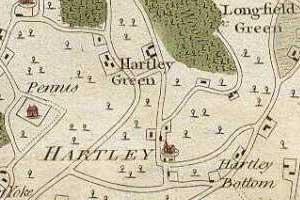Go To Section
Great Marlow
Borough
Available from Cambridge University Press
Background Information
Right of Election:
inhabitants paying scot and lot1
Number of voters:
245 in Nov. 1640 (franchise extended to all male inhabitants)2
Elections
| Date | Candidate |
|---|---|
| aft. 7 May 1624 | HENRY BORLASE |
| THOMAS COTTON | |
| c. Apr. 1625 | THOMAS COTTON |
| JOHN BACKHOUSE | |
| c. Jan. 1626 | SIR WILLIAM HICKS , bt. |
| JOHN BACKHOUSE | |
| c. Feb. 1628 | (SIR) JOHN BACKHOUSE |
| SIR MILES HOBART |
Main Article
Situated close to the Buckinghamshire-Berkshire border ‘where the Thames winds itself round the bottom of the hills’, Great Marlow was characterized by Camden as ‘a pretty considerable town’, which owed its importance chiefly to the confluence of river traffic to London and good road connections to both Reading and Chipping Wycombe.3 Grants and commissions for the repair of the timber bridge, a structure remarked upon by John Leland when he visited in 1535, can be traced back to at least the thirteenth century, by which time the town had a regular market and two annual fairs.4 The local economy was sustained mainly by trade in wheat, hides and cloth; the town also had a significant hospitality industry, boasting at least nine registered inns and alehouses in 1577.5 Elizabeth I honoured Marlow with a visit in 1592; and in 1600 townsman John Rotherham bequeathed £40 towards procuring a charter of incorporation.6 However, no such charter was ever obtained, and the borough remained under the control of the lords of the manor, the Paget family, based at Beaudesert in Warwickshire. Although William, 4th Baron Paget, was restored to the peerage early in James’s reign, he seems to have played no discernable role in regaining the town’s franchise, first mooted in the 1621 Parliament and more vigorously pursued in 1624 by William Hakewill*, a local lawyer who had acted on Marlow’s behalf since at least 1617 in disputes concerning the repair of the bridge and other charitable causes.7
Marlow sent Members to five Parliaments between 1301 and 1307, but thereafter its representation lapsed. On 18 May 1621 Sir George More reported to the Commons that the privileges committee ‘thinketh fit new writs should be granted’ for the boroughs of Great Marlow, Amersham, Wendover and Hertford, whereupon each town was ordered to submit evidence to the king’s counsel. By the time the towns’ cases were referred back to the privileges committee on 24 Nov., however, the Parliament was preoccupied with thoughts of war with Spain, and soon thereafter the session was terminated before further progress could be made.8 In 1624 Hakewill submitted petitions on behalf of the three Buckinghamshire boroughs. Report was made from the privileges committee on 4 May, again in favour of re-enfranchisement, ‘of which resolution of the committees His Majesty taking notice did (before the same was reported to the House) send unto the two chief justices’, who also certified their assent.9 Writs were accordingly issued three days later.10 The exact date of the election is unknown, as is the number of voters at Marlow, since no election indentures or borough records survive for this period. The franchise, left ill-defined in the absence of a charter, was probably limited (as at Amersham) to inhabitants paying scot and lot. This is certainly the implication of a Commons’ ruling of 1679, although the vote was thrown open to all male inhabitants in November 1640. The town’s only municipal officers, its two constables, acted as returning officers.11
It seems likely that Hakewill was assisted in his preparation of the boroughs’ petitions by Sir Robert Cotton*, whose library housed most of the early parliamentary rolls and sources of precedents upon which Marlow’s case rested.12 This presumably explains the return of Cotton’s son, Thomas, in 1624, together with Henry Borlase of nearby Little Marlow, the younger son of Sir William Borlase*, a leading member of the local gentry who re-endowed the grammar school at Marlow in memory of Henry when the latter died in December 1624.13 Thomas Cotton was re-elected in 1625, plumping for Marlow rather than Morpeth in Northumberland, where he had also been returned on the recommendation of his father-in-law, Lord William Howard of Naworth. He was joined by a kinsman of Sir William Borlase, John Backhouse, who represented the borough in the first three Caroline Parliaments. In 1626 the other seat went to Sir William Hicks bt., son-in-law of Lord Paget; and in 1628 the borough returned Sir Miles Hobart, owner of the neighbouring manor of Harleyford. It seems unlikely that any of Marlow’s Members received wages during the early Stuart period.
Author: Rosemary Sgroi
Notes
- 1. T.A. Hume, ‘Bucks. and Parl.’, Bucks. Recs. xvi. 97.
- 2. D. Hirst, Representative of the People?, 99.
- 3. W. Camden, Britannia (1722), i. 309; R. Gibbs, Bucks. Misc. 68-9.
- 4. J. Leland, Itinerary ed. L. Toulmin-Smith, i. 111; VCH Bucks. iii. 65-70.
- 5. Cent. Bucks. Studs. D-X423/1.
- 6. J.E.L. Wrench, Hist. Gt. Marlow Church, 7-13; PROB 11/97, f. 28v.
- 7. C93/7/3.
- 8. CJ, i. 624a; 643b; CD 1621, ii. 380; iv. 360, 434.
- 9. CJ, i. 697b; ‘Earle 1624’, f. 169r-v; Eg. 2723, f. 104.
- 10. SP15/43/62, ff. 150-2; B. Willis, Notitia Parliamentaria Bucks. 34-5; C231/4, f. 165.
- 11. Hirst, 86, 99; Hume, 97; VCH Bucks. iii. 69-70.
- 12. Cott., Julius C.III, ff. 316, 317, 334; K. Sharpe, Sir Robert Cotton, 189.
- 13. VCH Bucks. ii. 214-15; iii. 66; Wrench, 7-13.

